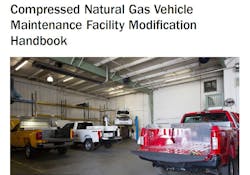Compressed Natural Gas Vehicle Maintenance Facility Modification Handbook
To ensure the safety of personnel and facilities, vehicle maintenance facilities are required by law and by guidelines of the National Fire Protection Association (NFPA), the International Mechanical Code (IMC), and the International Fire Code (IFC) to incorporate certain building/structural design features. They are also required to be fitted with certain fire protection equipment and devices because of the potential for fire or explosion if fuel leaks or spills. All fuels have an explosion or fire potential if specific conditions are present; however, the means of ensuring safety are different based upon the properties of different fuels.
The hazard presented by liquid fuels, such as gasoline and diesel, results from the spillage of these liquids and subsequent ignition of vapors, causing a fire or explosion. Facilities that maintain liquidfueled vehicles and implement appropriate safety measures are protected with ventilation systems designed to capture liquid fuel vapors at or near floor level. To minimize the potential for ignition in the event of a spill, receptacles, electrical fixtures, and hotwork operations, such as welding, are located outside of these areas.
Facilities that maintain vehicles fueled by natural gas require implementation of different safety measures. Compressed natural gas (CNG) is composed of mostly methane (CH4) with slight amounts of other hydrocarbons. CNG is lighter than air and will therefore rise to the ceiling of the maintenance facility and quickly dissipate rather than remaining at or near floor level like liquid
fuel vapors in the event of a release. If concentrations of 5 percent–15 percent by volume of natural gas encounter an ignition source, the natural gas may ignite, with potentially serious results. However, due to natural gas’s ability to rapidly dissipate, this concentration is rarely seen in practice.
The lower flammability limit (LFL) for CNG (5.3 percent) is considerably higher than that for gasoline (1.4 percent) or for diesel (0.6 percent). The specific properties of methane, as well as other vehicle fuels, are given in Appendix A.
Facilities that maintain CNG vehicles indoors must also be protected against fire and explosion. Although some of the means of protection for CNG vehicle maintenance facilities are similar to those used for liquidfueled vehicles (ventilation and elimination of ignition sources), the types and placement of the protection equipment are different because of the gaseous nature of the fuel and its properties. CNG maintenance facilities may also require additional safeguards, such as combustiblegas detectors and control systems or specialized space heating, which are not needed in facilities servicing liquidfuel vehicles.
